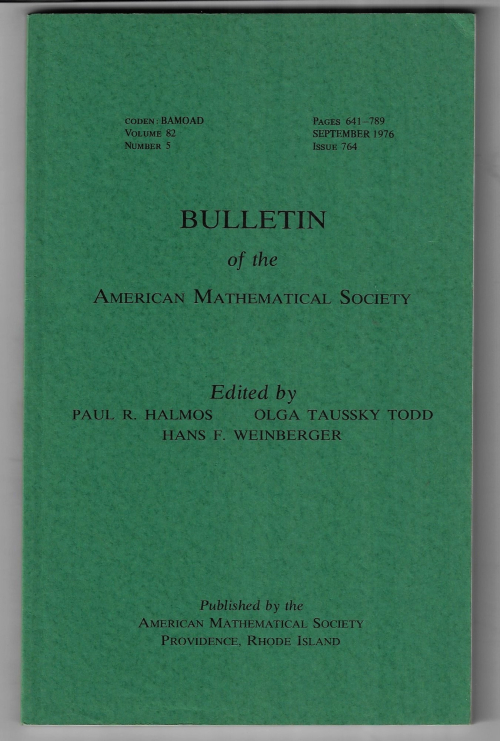APPEL, Kenneth and Wolfgang Haken, "Every Planar Map is Four Colorable", in Bulletin of the American Mathematical Society, 1976, vol 82 No. 5 pp. 711-712, September 1976, in the issue of pp 641-789. Original wrappers. Very fine copy—beautiful. . $450
 This is the announcement of the proof of the four color conjecture (4CC), cited 1800+ times.
This is the announcement of the proof of the four color conjecture (4CC), cited 1800+ times.
“The four color theorem is a theorem in topology that states that no more than four colors are required to ensure than no two contiguous regions on a map have the same color. The question was first posed by Francis Guthrie in 1852 but wasn't proven until 1976 when University of Illinois mathematicians Kenneth Appel and Wolfgang Haken proved it using a computer. This was the first major theorem proven using a computer [using 1200 hours of 1975/6 computer time].”--Wenner, History of Physics
“The four-color theorem states that any map in a plane can be colored using four-colors in such a way that regions sharing a common boundary (other than a single point) do not share the same color. This problem is sometimes also called Guthrie's problem after F. Guthrie, who first conjectured the theorem in 1852. The conjecture was then communicated to de Morgan and thence into the general community. In 1878, Cayley wrote the first paper on the conjectureSix colors can be proven to suffice for the ![]() case, and this number can easily be reduced to five, but reducing the number of colors all the way to four proved very difficult. This result was finally obtained by Appel and Haken (1977), who constructed a computer-assisted proof that four colors were sufficient. However, because part of the proof consisted of an exhaustive analysis of many discrete cases by a computer, some mathematicians do not accept it. However, no flaws have yet been found, so the proof appears valid. ”--Wolfram Mathworld,
case, and this number can easily be reduced to five, but reducing the number of colors all the way to four proved very difficult. This result was finally obtained by Appel and Haken (1977), who constructed a computer-assisted proof that four colors were sufficient. However, because part of the proof consisted of an exhaustive analysis of many discrete cases by a computer, some mathematicians do not accept it. However, no flaws have yet been found, so the proof appears valid. ”--Wolfram Mathworld,



Comments